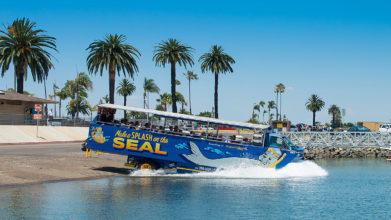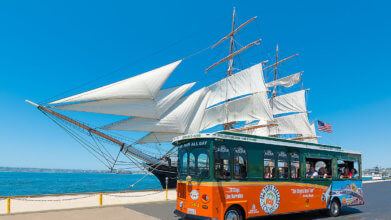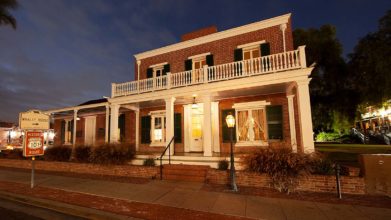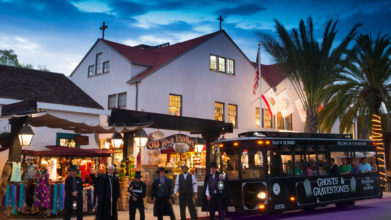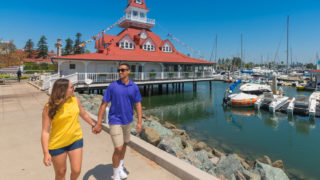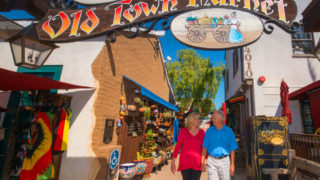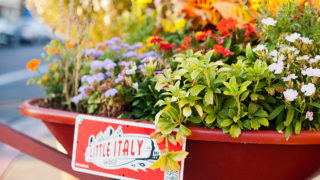Must-See Murals, Sculptures and Public Art in San Diego
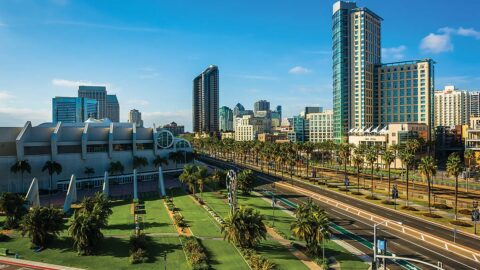
San Diego is a vibrant cultural city that hosts an incredible array of public art. From the colorful murals decorating local neighborhoods to the thought-provoking sculptures in its public parks, the city is a canvas teeming with artistic expressions. The art here is not confined within the four walls of a gallery. Rather, it spills out onto the streets, inviting both locals and tourists to engage, interpret, and appreciate. Come, let’s embark on an enchanting journey through some of San Diego’s must-see murals, sculptures, and public art pieces.
San Diego Murals
“Smile, You’re in San Diego”
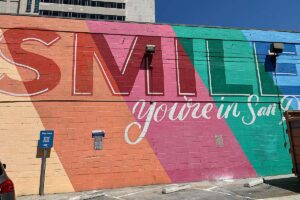
About “Smile, You’re in San Diego”
Located in the heart of San Diego, the “Smile, You’re in San Diego” mural stands as a vibrant testament to the city’s artistic flair and welcoming spirit. Crafted by Pandr Design Co. in 2018 as part of a tourism campaign, this 1,100-square-foot masterpiece has quickly become an iconic landmark, drawing visitors and locals alike to bask in its colorful allure. Dominated by a massive 22-by-54-foot display of the word “SMILE,” the mural injects a burst of energy into the urban landscape, serving as a beacon of positivity and joy. Against the backdrop of San Diego’s bustling streets, the mural stands out as a prime example of San Diego art, blending urban vibrancy with creative expression.
In an age where social media reigns supreme, the “Smile, You’re in San Diego” mural has emerged as one of the city’s most coveted Instagrammable spots. Its kaleidoscope of hues and playful design elements provide the perfect backdrop for countless selfies and group photos, immortalizing memories of laughter and happiness against a backdrop of San Diego’s skyline. As visitors pause to capture the moment, the mural’s message resonates deeply, encapsulating the warmth and hospitality for which San Diego is renowned. In a city renowned for its rich cultural tapestry and artistic diversity, the “Smile, You’re in San Diego” mural stands as a testament to the enduring power of San Diego art to inspire and uplift all who encounter it.
“SeaWalls: Murals for Oceans”
Location: “SeaWalls: Murals for Oceans” brings its powerful message to San Diego’s 3804 Fourth Avenue, offering a striking visual reminder of our oceans’ plight.
About “SeaWalls: Murals for Oceans”
“SeaWalls: Murals for Oceans” has been transforming the streets of San Diego since 2016, bringing captivating artworks like the stunning mural in Hillcrest, a testament to the city’s vibrant art scene. Crafted by artist Jet Martinez, this mural not only adds to San Diego’s artistic legacy but also serves as a poignant reminder of the urgent need to protect our oceans. Through vibrant colors and intricate brushstrokes, Martinez emphasizes the importance of using local or wild flora, intertwining environmental consciousness with artistic expression. This Hillcrest masterpiece is just one example of SeaWalls’ mission to educate and raise awareness about marine conservation, turning San Diego into a canvas for both art and activism. Each mural tells a unique story, conveying the urgency of preserving marine ecosystems and inspiring action among viewers. By fusing creativity with environmental advocacy, “SeaWalls: Murals for Oceans” transcends boundaries, fostering a deeper connection between art and stewardship while igniting crucial conversations about our responsibility to protect the seas for generations to come.
“La Colors”
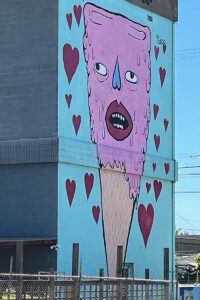
About “La Colors”
La Colors,” a vibrant mural located in the heart of Barrio Logan, is a masterpiece created by artist Paola Villasenor. This captivating piece of art pays homage to the local neighborhood paleteros — the ice cream vendors who are a staple of the community. The mural, filled with rich colors and intricate details, reflects the culture and spirit of Barrio Logan, as perceived through the eyes of these everyday heroes. The charm of “La Calors” lies not only in its artistic brilliance but also in its ability to narrate the story of a community through vivid imagistic language.
“Colossus”
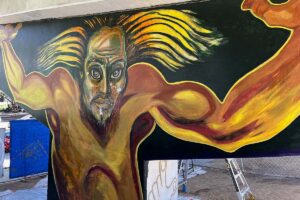
About “Colossus”
“Colossus,” a masterpiece painted by Torero in 1975, stands as a beacon of cultural significance within San Diego’s vibrant art scene. As one of the most renowned murals in Chicano Park, a sprawling seven-acre sanctuary for artistic expression, “Colossus” is a testament to the park’s rich heritage. Born from the collaborative efforts of muralists in the early 1970s, including the talented Mario Torero, the Chicano Park project aimed to celebrate and preserve Chicano culture through public art. Depicting a larger-than-life figure reminiscent of Atlas from Greek mythology, “Colossus” portrays a man holding up a bridge, evoking themes of strength and resilience. This iconic mural not only adds to the cultural fabric of San Diego art but also serves as a powerful symbol of community pride and identity.
“Love Your H2O”
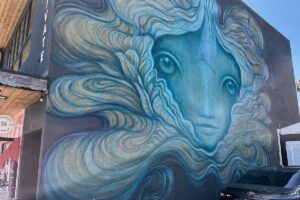
About “Love Your H2O”
Crafted by the talented artist Gloria Muriel, known affectionately as “Glow,” this mural serves as a vibrant testament to her captivating artistic vision. Originally hailing from Mexico City and now residing in the heart of San Diego, Muriel infuses her work with a mesmerizing blend of surrealism and whimsy. Throughout her illustrious career, she has drawn inspiration from the divine feminine, weaving intricate narratives that celebrate the beauty and interconnectedness of all life.
“Love Your H2O” stands as a poignant reminder of the importance of cherishing our planet’s most precious resource: water. With its dreamy hues and ethereal imagery, the mural invites viewers to reflect on their relationship with the natural world. Muriel’s artistry transcends mere aesthetic appeal, sparking conversations about environmental stewardship and the need to protect our oceans, rivers, and lakes. As a cherished gem in the crown of San Diego art, “Love Your H2O” serves as a beacon of inspiration, encouraging individuals to foster a deeper connection with nature and embrace a more sustainable way of living.
“Crushing It”
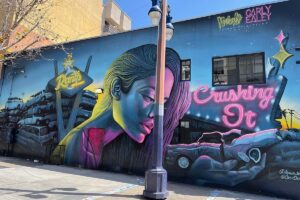
About “Crushing It”
“Crushing It” emerges as a collaborative masterpiece born from the creative minds of Carly Ealey and Christopher Konecki, enriching San Diego’s artistic landscape with its unique blend of vision and execution. This striking mural serves as a beacon of artistic expression, drawing viewers into a mesmerizing world where reality intertwines with imagination. At the heart of the mural lies a captivating scene, where a woman gracefully holds a crushed car amid the raw beauty of a junkyard setting.
What sets “Crushing It” apart is not only its visual splendor but also its underlying narrative and symbolism. Through vibrant colors and intricate details, the mural invites viewers to contemplate themes of resilience, transformation, and empowerment. The juxtaposition of deep blues against the radiant pink neon “Crushing It” sign adds depth and contrast to the composition, further enhancing its impact on passersby. Beyond its aesthetic appeal, “Crushing It” serves as a source of inspiration and encouragement, offering a moment of reflection and positivity amid the hustle and bustle of urban life.
As spectators pause to admire the mural’s beauty, they become part of a larger narrative unfolding within San Diego’s vibrant art community. “Crushing It” not only showcases the talent and creativity of its creators but also fosters a sense of connection and belonging among those who encounter it. It stands as a testament to the power of public art to spark dialogue, evoke emotion, and ignite change. In a city renowned for its cultural diversity and artistic innovation, “Crushing It” shines brightly as a testament to the enduring spirit of San Diego art.
San Diego Public Art
Breaking of the Chains
Location: The Breaking of the Chains monument is a striking symbol of emancipation, installed along San Diego’s Martin Luther King Jr. Promenade. The monument stands tall as a beacon, celebrating the spirit of resilience and hope.
About Breaking of the Chains
Breaking of the Chains, erected in 1995, stands as a powerful testament to the enduring legacy of civil rights icon Martin Luther King Jr. Crafted by sculptor Mel Edwards, this towering metal sculpture commands attention, as it symbolizes the relentless struggle against discrimination and oppression. Rising tall and imposing, the artwork embodies the spirit of resilience and defiance, serving as a visual reminder of the ongoing fight for justice and equality. At its base lies a poignant plaque adorned with a profound quote by Martin Luther King Jr., urging individuals to combat hate with love and to embrace the ethic of love at the core of our existence.
Nestled within its intricate metalwork lies a profound message of hope and unity, resonating with viewers from all walks of life. Breaking of the Chains not only pays homage to the extraordinary life and teachings of Martin Luther King Jr. but also invites contemplation on the enduring struggle for civil rights and social justice. As spectators pause to admire its striking form, they are compelled to reflect on the profound impact of King’s legacy and the ongoing pursuit of a more just and inclusive society. Breaking of the Chains stands as a beacon of hope and inspiration, reminding us of our collective responsibility to break the chains of hate and embrace the transformative power of love in our quest for a brighter future.
Fault Whisper
Location: Visit Fault Whisper at Fault Line Park, situated at 1433 Island Ave, San Diego, CA 92101, offering a unique blend of art and science to visitors.
About Fault Whisper
Crafted by the artistic duo Living Lenses, comprising Po Shu Wang and Louise Bertelsen, Fault Whisper merges art with technology in a mesmerizing display of interactive public art. Nestled within the park, this installation incorporates a remote eavesdropping function that invites visitors to engage with the surrounding environment in a novel way. At the heart of the artwork lies a shallow fault rupture of the Rose Canyon Fault System, marked by two stainless steel spheres positioned on opposite sides of the fault line.
One of these spheres, located on the west side, features a viewfinder that allows viewers to peer across the park to the east sphere. Installed in 2015, the viewfinder precisely aligns the east sphere at the center of its sightline. However, any future movement along the fault line will cause an offset, noticeable to those observing through the viewfinder. To capture these subtle shifts in the Earth’s movement, an accelerometer positioned below the spheres monitors seismic activity in real time.
The data collected by the accelerometer is transformed into musical notes, gently broadcasted from the west sphere’s viewfinder. As visitors listen to the ethereal melodies emanating from the installation, they become attuned to the subtle rhythms of the Earth’s movements. Fault Whisper not only offers a mesmerizing aesthetic experience but also serves as a poignant reminder of San Diego’s dynamic landscape and the constant interplay between nature and human innovation. This captivating fusion of art and science stands as a testament to the ingenuity of San Diego public art, inviting viewers to explore the intersection of creativity and exploration in a truly immersive way.
Fallen Star

About Fallen Star
In a remarkable fusion of art and engineering, Korean artist Do Ho Suh embarked on an ambitious project to suspend a house from the seventh floor of Jacobs Hall. This groundbreaking installation marks Suh’s first major permanent endeavor and continues his exploration of themes such as displacement, perception, and the concept of “home.” Positioned at an intriguing angle, the cottage appears to defy gravity as it juts out from the edge of Jacobs Hall, creating a striking juxtaposition against the modern architectural backdrop.
Installed at UC San Diego in July 2012, Fallen Star swiftly rose to prominence as one of the campus’ iconic landmarks, proudly joining the prestigious Stuart Collection of San Diego public art. Visible from notable campus locations, such as Geisel Library and Warren Mall, the house beckons curious onlookers to explore its whimsical allure. Surrounding the structure, a meticulously landscaped garden featuring East Coast plants and a winding brick path adds to the enchantment, leading visitors to the quaint front door.
Stepping inside, visitors are greeted by a meticulously furnished interior, where every detail reflects the artist’s meticulous craftsmanship. Despite its unconventional positioning, the 15-by-18-foot house exudes warmth and familiarity, inviting guests to ponder the meaning of “home” in a world marked by constant flux and change. Aptly christened with the fictional address 72 Blue Heron Way, Fallen Star is a poignant reminder of the human desire for stability and belonging amid life’s unpredictable journey.
San Diego Sculptures
Birds Words
Location: Located at B Street Pier — 1140 N Harbor Drive, San Diego, CA 92101 — Birds Words adorns the waterfront of San Diego with its artistic allure. Positioned within the lively atmosphere of the pier, visitors can readily engage with this distinctive installation while relishing panoramic views of the bay.
About Birds Words
Renowned artist Pae White was chosen to create artwork for the revamped B Street Pier, drawing inspiration from her memories of sun-soaked reading sessions. These memories have been translated into a sheltering canopy of words, intertwining seamlessly with the pier’s activities. Visitors engaging in various experiences, from purchasing harbor cruise tickets to dining at Carnitas Snack Shack, are enveloped in the integration of art and architecture. Birds Words captivates with its steel and aluminum canopy, glass panels reflecting the bay’s hues, and a restroom adorned with cryptic letters. While some of White’s words are visible from below, others remain a mystery, observed only by passing seagulls and airplanes, adding an element of intrigue to the installation.
Arbre de Serpents (Serpent Tree)
Location: Situated within Waterfront Park at 1600 Pacific Highway, San Diego, CA 92101, the Serpent Tree offers a whimsical escape amid the bustling energy of the waterfront.
About Arbre de Serpents (Serpent Tree)
Located within the vibrant ambiance of Waterfront Park, where mothers stroll with their babies, friends engage in spirited soccer matches and children and dogs frolic amid the arcing fountains, stands a captivating symbol of whimsy and creativity — the Serpent Tree by the esteemed artist Niki de Saint Phalle.
Gleaming under the radiant Californian sun, this rainbow-colored, multi-headed snake embodies Saint Phalle’s distinctive artistic flair. Its surface, adorned with a mosaic of stained glass and mirrors, dances with light, reflecting the exuberance of the park’s lively atmosphere. These shimmering mosaics pay homage to the adjacent County Administration Building’s tiles and the base of Donal Hord’s monumental 1939 sculpture Guardian of the Water.
Saint Phalle, who resided in La Jolla during the final years of her life, found solace and healing in her art, transcending childhood trauma to become a beacon of creativity and resilience. Describing herself and her creations as embodiments of “color, joy, abundance,” Saint Phalle’s legacy reverberates throughout Waterfront Park and beyond.
Visitors to the park can discover more of Saint Phalle’s enchanting sculptures near the south fountains and playground, as well as in prominent locations, such as Balboa Park, Downtown San Diego, La Jolla, and Escondido. Each piece invites viewers into a world where imagination knows no bounds and where the spirit of the artist continues to inspire and uplift all who encounter her work.
Unconditional Surrender / Embracing Peace (Kissing Sailor Statue)
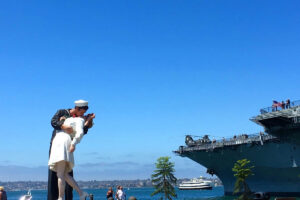
About the Kissing Sailor Statue
Crafted by artist John Seward Johnson II, the “kissing sailor” statue stands impressively at 25 feet tall and weighs a hefty 6,000 pounds. Known as Unconditional Surrender, it’s officially been dubbed the “Embracing Peace” statue by the City of San Diego. Walking beneath this monumental work and gazing upward offers a profound sense of its sheer magnitude.
The statue, towering over the San Diego Harbor, immortalizes the iconic embrace shared between a sailor and a nurse in the jubilant aftermath of World War II in 1945. The statue was removed in 2012 but reinstated in 2013 with a replica. This replacement version, solid bronze in construction, stands in stark contrast to the original, which was crafted from urethane foam.
Not confined to San Diego, variations of this statue grace locations worldwide, including Hamilton, New Jersey; Pearl Harbor, Hawaii; and Normandy, France. Each iteration pays homage to the historic moment of unconditional surrender and the enduring quest for peace.
Pacific Soul Statue
Location: Situated along the picturesque Pacific Hwy in San Diego, CA, the Pacific Soul Statue commands attention with its imposing stature and intricate design. This prime location offers visitors a serene backdrop of the Pacific Ocean, enhancing the sculpture’s significance and allure.
About the Pacific Soul Statue
Barcelona-based artist Jaume Plensa drew inspiration from the vastness of the ocean when he conceived his monumental 25-foot sculpture, the Pacific Soul Statue, a notable addition to San Diego’s public art landscape. This captivating artwork, situated along the Pacific Hwy in San Diego, CA, embodies a delicate and lacy silhouette, intricately crafted from letters sourced from eight distinct alphabets, including Cyrillic, Hindi, and Chinese. Plensa’s profound belief in the intrinsic connection between language, culture, and humanity permeates the essence of the sculpture. He asserts that, while language is deeply rooted in individual cultures, it also serves as a universal conduit that binds us together. As with all forms of art, the Pacific Soul Statue invites viewers to embark on their own personal interpretations, offering a contemplative space where individual reflections and collective experiences converge.
El Cid Campeador
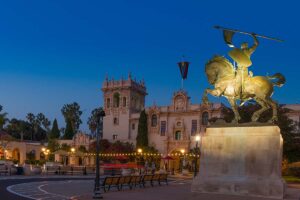
About El Cid Campeador
Crafted by the talented artist Anna Hyatt Huntington, El Cid Campeador is an outdoor equestrian sculpture that immortalizes the legendary Spanish knight, El Cid. This masterpiece, cast in bronze, came to life in 1927 and was unveiled with a great ceremony on July 5, 1930. Standing at approximately 11 feet tall, 9 feet wide, and 7 feet deep, with a base spanning about 16 feet in diameter, the statue exudes a commanding presence. Its base, constructed from concrete or Indiana limestone, measures approximately 11 by 14 by 8 feet. The impact of this iconic statue extends far beyond San Diego, with replicas gracing other cities, such as Buenos Aires, New York City, San Francisco, Seville, and Valencia, each serving as a testament to the enduring legacy of El Cid.
Morning (Hord)
Location: Morning (Hord), also referred to as Morning Statue, graces the landscape of San Diego’s Embarcadero Marina Park North, nestled in the picturesque scenery of the U.S. state of California.
About Morning (Hord)
Morning, alternatively referred to as Morning Statue, stands as an outdoor marvel, a testament to the artistic vision of Donal Hord. Crafted from black granite, this 6-foot, 3-inch sculpture captures the essence of vitality with its depiction of a muscular young man engaged in a graceful stretch. Originating between 1951 and 1956, Morning remained within the sanctuary of Hord’s residence until its acquisition by the Port of San Diego in 1983, marking its transition from a private treasure to a cherished public monument.
Why Old Town Trolley Is a Great Way To See San Diego Murals and Art
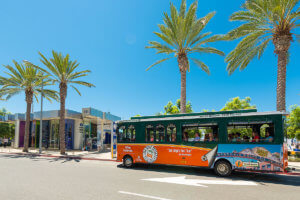
FAQs
Where are some notable outdoor sculptures located in San Diego?
San Diego is home to an impressive collection of outdoor sculptures that are scattered across the city. Notable among them is Unconditional Surrender by Seward Johnson, a towering statue located on the waterfront downtown. The Stuart Collection at the University of California, San Diego campus is another must-see, with awe-inspiring works like Fallen Star by Do Ho Suh and Sun God by Niki de Saint Phalle. Balboa Park, too, houses several noteworthy sculptures, including Nikigator and Coming Together.
What are some prominent sculptures in San Diego?
San Diego, California is home to an impressive collection of public art, with many notable sculptures that add character to the city’s cultural landscape. Some of the most prominent include Unconditional Surrender at the USS Midway Museum, a towering, iconic depiction of a sailor kissing a nurse at the end of World War II, and Fallen Star at the UC San Diego campus, an installation that presents a small house precariously perched on the edge of a building. The Sun God sculpture, also located on the UC San Diego campus, is another famous work, known for its bright colors and whimsical design. Finally, Fish Tree in the Gaslamp Quarter, a unique piece that combines elements of nature and marine life, is another must-see sculpture in San Diego.
Are there any famous murals in San Diego that I shouldn’t miss?
San Diego is home to some incredible murals that add a vibrant, creative touch to the cityscape. If you’re planning a visit, you definitely shouldn’t miss the stunning “North Park Murals.” This collection of street art is a mecca for art lovers and a testament to San Diego’s thriving creative scene. Another must-see is “Chicano Park,” located beneath the Coronado Bridge in Barrio Logan. It is known for its massive collection of murals celebrating Mexican-American and indigenous cultures. Lastly, the “La Jolla Murals” is a collection of artworks from internationally renowned artists scattered throughout La Jolla.
What is public art, and why is it important in San Diego?
Public art is a significant part of the cultural fabric of San Diego. It refers to artistic endeavors — inclusive of sculptures, murals, installations, and interactive exhibits — that are placed in public spaces and freely accessible to all. Public art in San Diego plays a crucial role in enriching the city’s cultural identity, encouraging community engagement, and promoting diversity and inclusivity. It enhances the cityscape, stimulates thoughtful dialogue, and provides residents and visitors alike with a deeper understanding of the city’s history and cultural evolution.
What is the easiest way to see all the murals in San Diego?
The easiest way to explore all the murals in San Diego would be through a self-guided tour. Numerous online resources and apps document the locations and details of these public art pieces. You can follow these digital guides at your own pace, pausing to appreciate each mural and its intricacies. Alternatively, for a more in-depth experience, consider joining a guided art tour. These tours often provide enriching context and history about the murals and the artists who created them.

